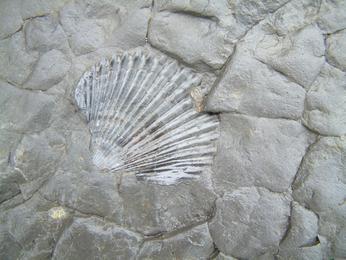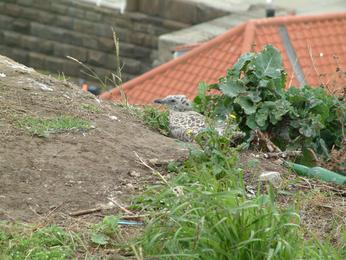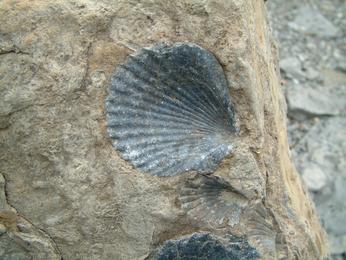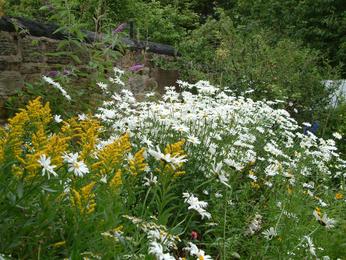Thursday 1st July – Barnsley Canal – Bird song is now fragmented into short bursts, chirrups, croaks, buzzes, tweets and the occasional full blown song from a Blackcap, Robin and Wren. Minute Cinnabar Moth caterpillars, their stripes barely visible, are feeding on Ragwort. Tiny froglets risk getting crushed underfoot as they hop around the tow-path.
Monday 5th July – Barnsley Canal – A young Bullfinch, dull in colour, but still flashing a bright white rump, drops down into the rushes and then up and away into the hedgerow. A much gaudier male follows the youngster. Even brighter still, two Kingfishers depart up the canal in flashes of sparkling turquoise. A Sparrowhawk is circling on up draughts high above Willowbank. Swifts are even higher still in the blue sky. The Little Owls must have bred near the fallen tree as there are now three sitting on the whitened branches. Tiger-striped Cinnabar moths are growing rapidly on their diet of Ragwort. A young Moorhen rushes noisily across the canal and into the safety of the reed margins.
Tuesday 6th July – Monk Bretton Priory – After seventeen years in Barnsley, I finally decide to visit the priory which is only a few miles from our home. The extent of the site is surprising although much of the remains are low walls. It was founded in 1154 as the Priory of St Mary Magdelene of Lund by Adam Fitswane. The area was called the Lund, from Old-Norse lundr meaning a sacred woodland grove. The area and housing estate around the priory is still called Lundwood. The Priory then became known as Monk Bretton Priory from the nearby village of Bretton. The foundation grant included large areas of land and income from churches and mills. In the Cluniac tradition, Adam’s original grant invited the Prior of the Cluniac Priory of St John, at Pontefract, to provide the Prior and the monks at Bretton and elect future Priors. However, Adam wanted independence and approached the senior Cluniac house at La Charite Sur Loire who agreed that Monk Bretton elect its own Priors. Pontefract violently opposed this and for over a hundred years fought a bitter war for control of this valuable Priory – grants of land had increased and the market charter for a weekly market and annual fair to be held was granted in 1249 to the monks of the Cluniac order by Henry III at Barnsley through its Bretton connections. Indeed, Pontefract sent armed forces to take over. Monks were arrested; Bretton retaliated locking out the Pontefract Prior. The Sheriff, Pope and King were eventually involved and a battle in 1276 resulted in three monks being killed. The dispute was resolved 1281, when Monk Bretton seceded from the Cluniac Order and became a Benedictine house. The monks left after the Dissolution. The incumbent Prior and two brethren bought 148 of the library books and moved to Worsbrough and continued to live a communal life. They were still a community in 1558. The buildings were robbed out, seven bells, church silver and 59 tons of lead from the roofs were taken away together with all moveable objects of any value and under various owners the buildings were rapidly demolished to provide building material for local landowners. For example, Thomas Wentworth bought the north aisle of the Priory church to add to his own church at Wentworth. As the ashlar outer stones were removed the inner rubble core of the walls collapsed until the whole site became a huge pile of rubble up to nine feet deep. But three buildings within the precinct escaped – the Gate House, Prior’s House and administration building. The latter has often been thought a Guest House but it lacks fireplace and garderobe and was probably the centre for the running the Priory’s vast estates and perhaps to house the extensive library. It has a rare medieval double pitched roof. These three buildings became dwellings and farm buildings to survive today.
Friday 9th July – The Fleets – Yesterday storms wreaked havoc across Southern and Eastern England. Trees and power cables down all over the place. In South Yorkshire there was a stiff wind and a lot of rain. Yet, surprisingly there is not a great deal of water pouring over the weir at Old Mill Bridge. This tends to indicate that run off is very fast these days due to the large areas of housing and roadways and the areas of farm land being uninterrupted by hedge rows etc. A Buttercup shining yellow brings relief to the grey gloom cast by the iron sky.
Saturday 10th July – Robin Hoods Bay – A weekend of fossil hunting on the  north-east coast with Peter and Henry. Our original intention was to find a campsite near Whitby and range out from there. However, we find a site and after an initial enquiry are told from behind closed curtains “The man will be out in a minute”. So we wait, Peter gets butted in the groin by a goat and we wait. A second attempt at contact receives the same reply but also the information that the site (a slightly euphemistic description) charges £12 per tent per night – well over double the going rate. So we leave and head for Robin Hoods Bay. High above the village is a welcoming campsite at £4.50 per day. We set up camp, almost inevitably next to some people I know from Barnsley, and head down into the
north-east coast with Peter and Henry. Our original intention was to find a campsite near Whitby and range out from there. However, we find a site and after an initial enquiry are told from behind closed curtains “The man will be out in a minute”. So we wait, Peter gets butted in the groin by a goat and we wait. A second attempt at contact receives the same reply but also the information that the site (a slightly euphemistic description) charges £12 per tent per night – well over double the going rate. So we leave and head for Robin Hoods Bay. High above the village is a welcoming campsite at £4.50 per day. We set up camp, almost inevitably next to some people I know from Barnsley, and head down into the  bay. The hill down through the village to the sea is knee-grindingly steep. After a couple of pints of Jennings fine Cumberland ale, we head south along the beach. Recent storms have thrown up large drifts of kelp and other seaweeds. In the piles are sea sponges. I am not sure if these are the sponges known as “Dead Man’s Fingers”, but if so, they are aptly named. In the black stratas of Jurassic rock are Belemnites (the fossilised inner parts of a squid-like creature), fish bones and scales. A dead seal lies rotting – there have been reports the seal virus of several years ago has returned. Oystercatchers and Turnstones feed amongst the seaweed. A lot of fossilised wood turns up. We decide that the north side of the village may be more productive. However, as the tide is still high, this necessitates the imbibing of a few more pints before heading onto the beach. We wander along under cliffs which are clearly being eroded at a considerable rate. Kittiwakes and Fulmars are nesting, but not in great numbers. We find a few pieces of Ammonite but because we are unsure of the tides, we do not venture far.
bay. The hill down through the village to the sea is knee-grindingly steep. After a couple of pints of Jennings fine Cumberland ale, we head south along the beach. Recent storms have thrown up large drifts of kelp and other seaweeds. In the piles are sea sponges. I am not sure if these are the sponges known as “Dead Man’s Fingers”, but if so, they are aptly named. In the black stratas of Jurassic rock are Belemnites (the fossilised inner parts of a squid-like creature), fish bones and scales. A dead seal lies rotting – there have been reports the seal virus of several years ago has returned. Oystercatchers and Turnstones feed amongst the seaweed. A lot of fossilised wood turns up. We decide that the north side of the village may be more productive. However, as the tide is still high, this necessitates the imbibing of a few more pints before heading onto the beach. We wander along under cliffs which are clearly being eroded at a considerable rate. Kittiwakes and Fulmars are nesting, but not in great numbers. We find a few pieces of Ammonite but because we are unsure of the tides, we do not venture far.
Sunday 11th July – Robin Hoods Bay – It was clear from the evening before that the tide leaves large areas of beach uncovered for several hours. However, as high tide is not until noon, we head off to Whitby for the morning. We wander the shops in the old town. Popping into the smokery, we are told that the next batch of kippers will not be  ready for twenty minutes. We wander some more and then return to purchase a few pairs. The smoke house itself is a small wooden extension behind the small shop. It had been there for one hundred and twenty years or more (in the current owner’s family that is. Smoke houses would have been here for far longer.) Beams are shiny black and dripping with tar. Herrings are split and hung on hooks in pairs and a pile of shavings (and any kippers that fall off) is lit so that it smokes strongly. The herrings are hot smoked into kippers. We spend the afternoon wandering along the north beach of Robin Hoods Bay. There are large slabs of rock that are covered in fossilised shells. Other lumps are nothing but layers of fossilised oysters. Fish bones, vertebrates, razorfish like creatures, remains of belemnites, nautiluses and ammonites, crinoids and sea lilies are all found in the rock. Almost inevitably, I damage an ankle and am forced to return to the pub!
ready for twenty minutes. We wander some more and then return to purchase a few pairs. The smoke house itself is a small wooden extension behind the small shop. It had been there for one hundred and twenty years or more (in the current owner’s family that is. Smoke houses would have been here for far longer.) Beams are shiny black and dripping with tar. Herrings are split and hung on hooks in pairs and a pile of shavings (and any kippers that fall off) is lit so that it smokes strongly. The herrings are hot smoked into kippers. We spend the afternoon wandering along the north beach of Robin Hoods Bay. There are large slabs of rock that are covered in fossilised shells. Other lumps are nothing but layers of fossilised oysters. Fish bones, vertebrates, razorfish like creatures, remains of belemnites, nautiluses and ammonites, crinoids and sea lilies are all found in the rock. Almost inevitably, I damage an ankle and am forced to return to the pub!
Monday 19th July – The Fleets – The sun finally shines after a week of dull grey skies and rain. A Speckled Wood butterfly flits through the dappled light and shade of the woodland beside the River Dearne. The vegetation is lush. Himalayan Balsam is rife – pretty but an invasive introduction. Mallard are on the willow carr. Terns have discovered the water treatment windmills are a useful landing stage. A few minutes later they are high in the blue sky, screaming at one another. Small brown birds slip silently into the thick undergrowth and hedges. Raspberry canes are deep in brambles, pink fruits ripening.
Wednesday 21st July – Old Mill – Clouds hang threateningly overhead. The sun keeps attempting a breakthrough but disappears again. It is warm and muggy (worryingly ideal weather for blight on my potatoes). Tansy and Great Willowherb are in flower. The recent cold and wet weather seems to have had a dire effect on the butterfly population; I see one each of Gatekeeper and Small Tortoiseshell. It has been more advantageous for fungi and all the young Sycamore tree leaves are densely spotted with a form of blight. White Dead Nettle flowers are creamy coloured under the nettle like leaves. Hog Weed, Knapweed, St John’s Wort and various thistles are all flowering. Moorhens are numerous, many juveniles. Rowan berries are already ripening and providing Blackbirds with a sugar rich meal. A Whitethroat mutters on a dead bush. Crossing the river over the bridge that replaced the old aqueduct and a Green Woodpecker flies off through the trees.
Saturday 24th July – Willowbank – I head down the narrow lane that is actually called Willowbank. A new large house has been built on the right hand side – another old and large garden gone. The road opens out and an estate rises up the hill to the left. The railway cutting for the Leeds line runs along the other side. A bridge crosses the railway and then the lane leads down to Tinkers Pond – two ponds in fact. I detour along the edge of the steep hill that overlooks the Barnsley Canal and the valley of the River Dearne. A path leads down from the ponds to the canal. A mobile blacksmith is working on the hooves of horses kept in the fields beside the canal. I am a little worried that Dill the Dog will spook them, but she wanders past at heel without incident. Climb back up the hill towards the bottom of Greenfoot Lane. It is  the time for blue and purple flowers. Field Scabious, a blue-pink colour, is scattered across the hillside but not in great numbers. Patches of Tufted Vetch are deep purple.
the time for blue and purple flowers. Field Scabious, a blue-pink colour, is scattered across the hillside but not in great numbers. Patches of Tufted Vetch are deep purple.
Home – The garlic was dug earlier in the week and dried in the greenhouse. I am pleased with a yield of 3kg. The main flower patch is a glorious drift of large daisies and Golden Rod. Calabrese has grown well and must be cropped this weekend. I will dig another potato plant for dinner.
Tuesday 27th July – The Fleets – A pair of Sparrowhawks sit high above the willow carr, screaming. There are far more gulls on the lake than of recent, then the reason becomes clear – there are dead fish everywhere. Roach and Bream lay on the surface, many have drifted to the south end and there is a slight stench of decay building. A large Bream is on the surface gasping at the air. Terns have also arrived for the feast. Water is being pumped into the lake from the River Dearne, but given how often this is contaminated with effluent, it is hard to see how this will help. The wind generators stand idle in the centre of the water. A young and tatty leaf warbler feeds in the Hawthorns; it is difficult enough distinguishing the adults so I have no idea which species the young are.
Wednesday 28th July – The Fleets – A Kingfisher darts off up the Dearne from the wall of the weir. There is a large drift of Golden Rod shining bright yellow in the gloom under the trees by the bridge. The young Sparrowhawks are still crying in the trees. One is being harassed by four agitated Magpies. There are more dead fish floating on the surface of the lake; some quite large Carp and Bream are among the corpses. Water is still being pumped in and the level has risen so much that water pours out of the overflow pipe at the south end back into the river. An angler by his car asks why the lake is closed. I reply that it is because the fish are dead, pointing out the numerous white blobs on the surface. He has come down from Castleford to fish here because of the reputation as a good fishery.
Thursday 29th July – Silkstone Fall – Another hot day looms. It is humid in the woods. Like most conifer plantations, there is little bird song, just the occasional calls. A Stinkhorn fungus is covered in large black flies. Indeed, flies are buzzing around me in an unpleasant fashion whilst I am in the woods. There is a fine specimen of the Amanita group of toadstools by the path – probably the dangerously poisonous Panther Cap. I find a couple of Bay Boletus. Earth Balls are also beginning to emerge.
Saturday 31st July – Blackburn Meadows – It is cloudy but very warm and humid. The water level in the pond is very low. A Grey Heron stands hunched back on a spit of sand. Black-headed Gulls squabble in the shallow water. The banks beside the path are covered in flowers. Teasels stand high with little blotches of lilac flower on the bristly head. Perennial Sow-thistle have yellow dandelion-like flowers standing on long stalks above the rest of the greenery. Field Scabious, Meadow Cranesbills, and Lucerne are the blue to purple representatives; various thistles, Mallow, Knapweed, Red Campion, Great and Rosebay Willowherbs and Soapwort make up the reds and pinks with Bindweed and various umbellifers being white. Red Honeysuckle berries are already ripe.